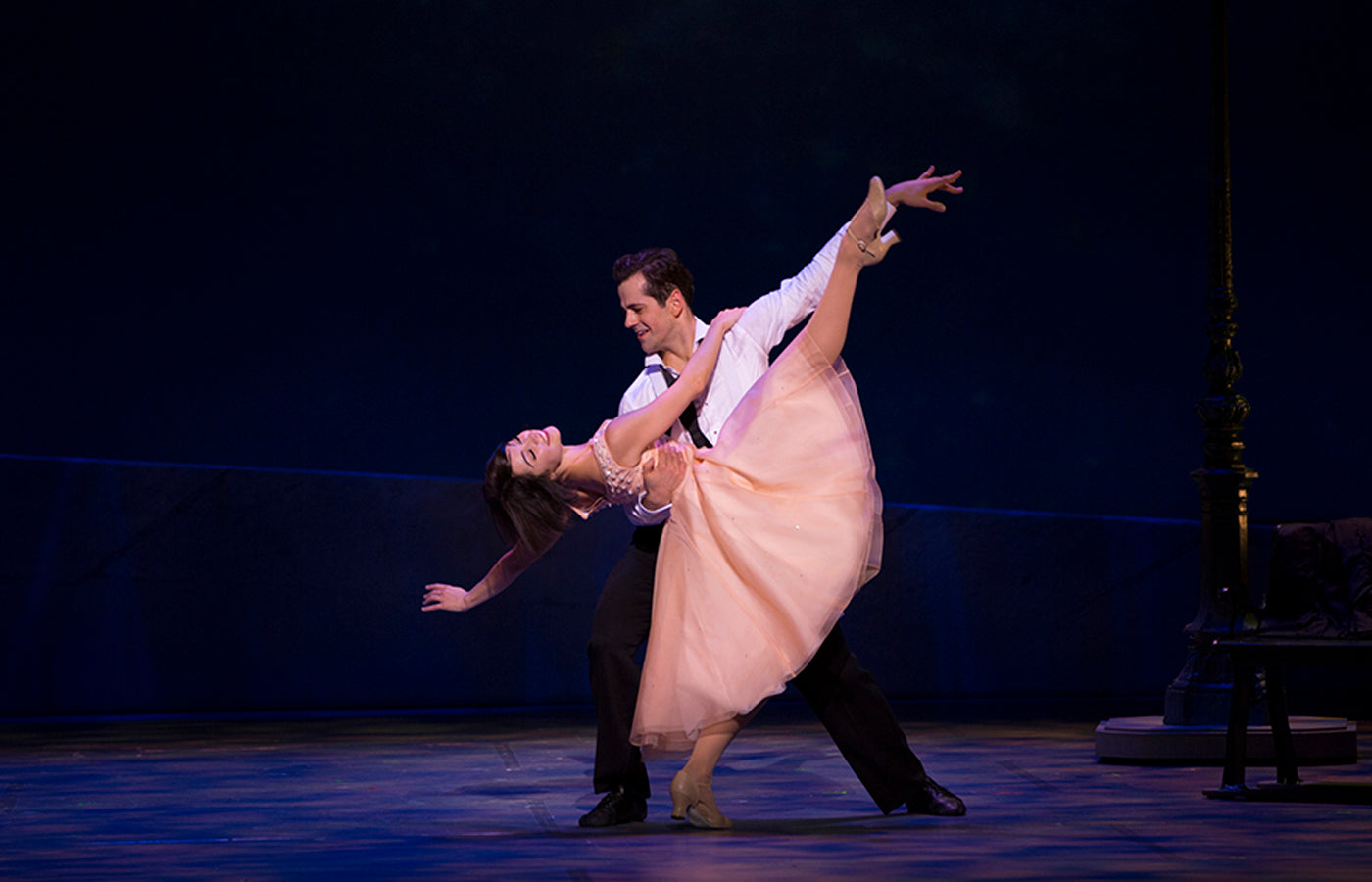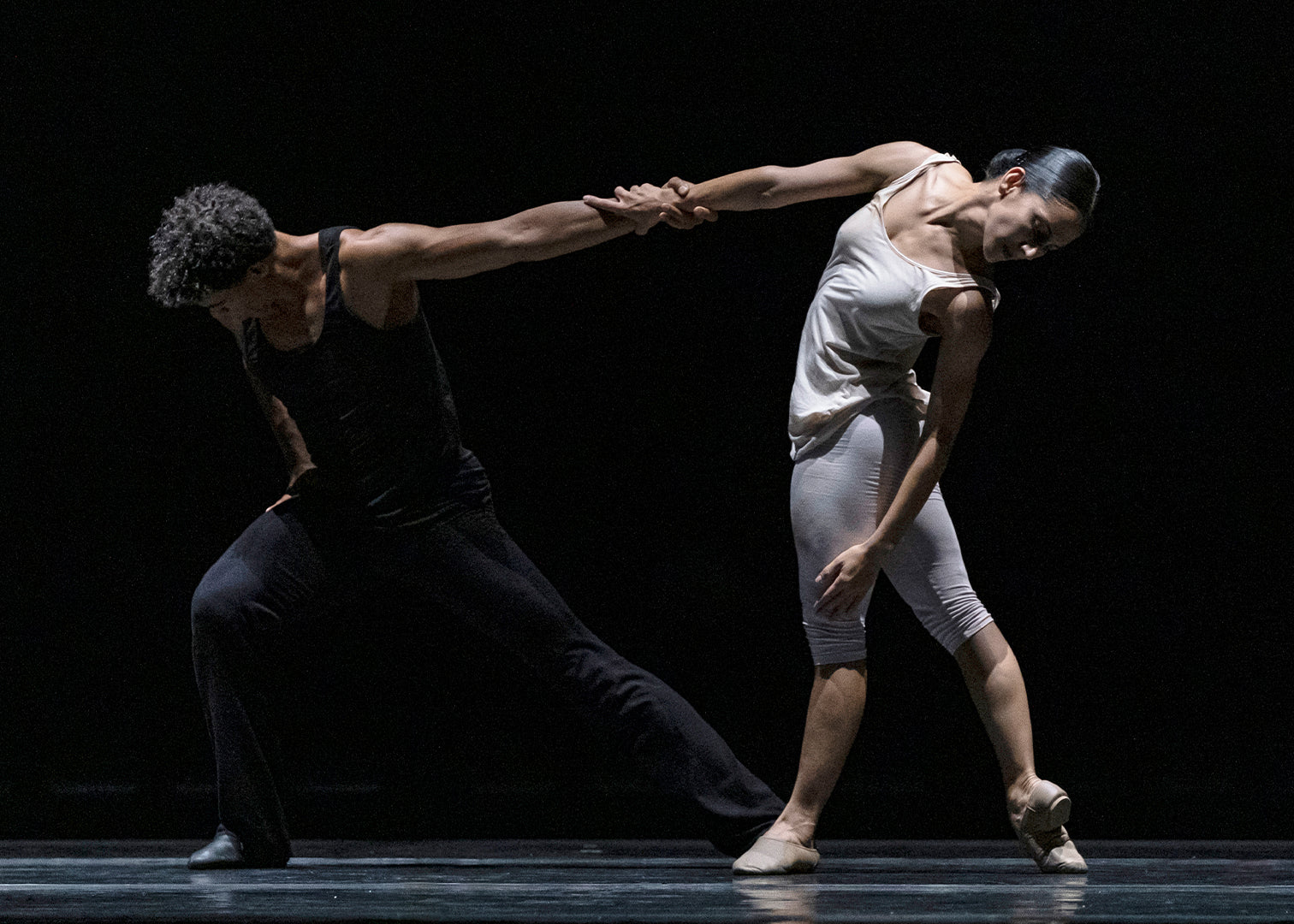And who even cares about the language and the books; the trip is made for that which is unavailable in the classroom. In Jerry’s case, he finds in love a cure for his memories of war, or at least that would be the widespread ideal in 1945, the time in which “American” is set. Romance was disdained by the Fascist-leaning Futurists; “a scorn for women,” is listed as one of the most important tenets in that manifesto. Which then made falling for one practically a patriotic act: “the fact that you move so beautifully more or less takes care of Futurism,” wrote Frank O’Hara.
Despite this, Jerry, an aspiring painter, still dabbles in slanted geometries and faceless portraits. During the opening sequence we see him clutching a sketchbook in earnest, his leg held out behind him in arabesque as he looks around as wide-eyed and light-sensitive as an impressionist. But when wooed by the heiress art collector Milo Davenport (played by Jill Paice), he forsakes his drawings en pleine air for Mondrian-esque abstraction. These two thematic elements—that of sleek, racy art absent of the human form and sex for the sake of money and convenience—are not unrelated, or at least not in this show. At one point Jerry and Milo go to a gallery where all sorts of Cubist gargoyles are on display; grabbing a frame from one of the paintings, she lifts it over their heads so it encircles them, as if they themselves are ready to hang on a wall. And for all matters of appearances and finances, they are.
Except that, as in the 1951 movie version, matters of the heart trump all. The stasis and surface appeal of Milo’s frames contrast directly against Lise Dassin, (played by Leanne Cope) the ingénue ballerina with whom Jerry falls in love. Brian Seibert has already pointed out aspects of the Romantic ballet from which Wheeldon seems to be drawing: the search for the One, the pas de deux echoing the woman’s solo that shows the increased height and range she can reach with a partner. But there’s another Romantic idea implicit in Wheeldon’s staging of “American.” He ties it to the belief of dance as a revelation of the authentic self: the restraints of mannered propriety are temporarily set aside in order to reach a truth inaccessible via any other means. It is no coincidence that Lise dances and Milo does not; in most story ballets the One dances en pointe while the wealthier, more eligible woman wears a long dress and walks around in heeled shoes, all social refinement with nothing to show for it. Love, then, can only be found with the one who dances; she comes to embody values rather than just signify them, and her heart is not only worn on her sleeve but made visible in the very movement of her arms.
Wheeldon takes this Romantic sensibility and places it in real, down-to-earth, 1945 time. Lise, for all her gracefulness, is a woman in the flesh. And she, unlike her movie equivalent who seems satisfied as a perfume shop associate, has career aspirations; she's a professional dancer, and a good one, making Jerry's dilettantism look like stuff of a child. This also means that her dancing is not just the product of the male dreamscape; during the seventeen-minute-long ballet set to Gershwin’s famous tune, Lise wears pointe shoes for real rather than having them as orthopedic enablers to Jerry's fantasy world.
In going to the show, I wasn't anxious that it would disappoint in comparison to the movie, which despite its high-gloss MGM sheen is nothing more than a showcase for Gershwin's tunes and "Kelly-sthenics" (so called by the New York Times at the time of the premiere). These song and dance sequences, so cutting-edge at the time—the ballet alone cost $450,000, the equivalent of over $4 million today—fail to rescue the plotless story from its outrageous non sequiturs and window-front vacuity. Jerry's rainbow dream serves as the emotional climax of the film, but at the end we're back at the black and white ball with the lovers walking into the shadows, and dawn feels a long ways away. (Vincente Minnelli made the movie during his messy divorce from Judy Garland.) From a dramatic point of view, the show surpasses its predecessor; during the ballet—which is shown from Lise’s rather than Jerry’s perspective—there’s a similar transition from white to color-saturated, but they remain vivid during the lovers’ reunion on the banks of the Seine.
Wheeldon is a great storyteller, a strength that was not apparent in “Alice in Wonderland,” his last full-length narrative ballet. High dance-Broadway cross-pollinations are rarely successful; as Arlene Croce noted of “Slaughter on Tenth Avenue,” "when Balanchine works directly with the materials of popular culture . . . he produces junk.”[1] Twyla Tharp eventually made a success of her “Movin' Out,” but only after several occasions during which half the audience walked out. Wheeldon's ability to subsume the choreography into a story follows directly in the line of Jerome Robbins. In “American,” the arms are relaxed, gestural, and the choreography feels so natural to the characters that you forget they're dancing. Fairchild, always impressive, astonishes in all capacities on the “American” stage. He arrives for the sensual pas de deux spiraling around Cope in a series of grands jetés, and all of a sudden the stage feels too small. If Hollywood could move past the idea that all male ballet dancers are either gay or Russian, they would scoop him up.
The show is about half dance, and when anyone starts singing or talking you wish they would shut up and get back to the ballet. Craig Lucas has reworked the script, but his meta-rhetorical statements on the mimetic capacity of art or lack thereof ("Life is not like your Hollywood movies") try to wink at us a little too overtly. The French accents, which sound as organic as maraschino cherries, win no favors either. So when the audience stands in ovation, as was the case when I went during preview season, and when the show receives a nigh-unanimous critical approval, it is the dancing that has won everyone over. Since the 1950s, when Clement Greenberg's treatises made abstraction all the rage and Balanchine upended ballet with his radical formalism, the capacity of pure dance to convey narrative has been in question. Wheeldon shows that not only can ballet tell the story, but sometimes the story cannot be told any other way.
[1] Arlene Croce, “Out of the Storeroom,” Afterimages (New York: Alfred A. Knopf, 1969), 309









comments